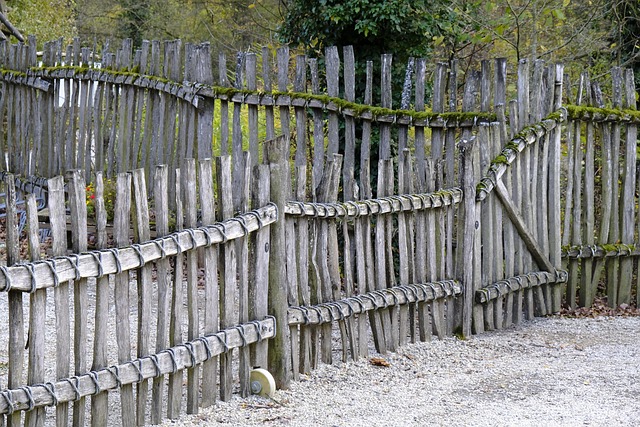Maintaining your New Bedford privacy fence is essential for both aesthetics and functionality. This guide provides homeowners with a comprehensive set of tips tailored to the unique needs of their properties. From understanding the material and regular cleaning routines to inspecting for damage, painting techniques, and when to call professionals, these steps ensure your fence remains a valuable asset that protects your privacy year-round.
- Understanding Your Privacy Fence's Material and Needs
- Regular Cleaning and Maintenance Schedule
- Inspecting for Damage: Common Issues to Look For
- Proper Painting and Staining Techniques for Protection
- Tools Required for Basic Fence Repairs
- When to Call in Professional Help for Major Repairs
Understanding Your Privacy Fence's Material and Needs
Privacy fences are an essential addition to any New Bedford homeowner’s outdoor space, offering a sense of seclusion and security. To ensure your fence remains in top condition, understanding its material and specific maintenance needs is crucial. Different types of privacy fences—from wood to vinyl—require unique care.
Regular cleaning, for instance, might involve using a pressure washer for wooden fences to remove accumulated dirt and debris, while a soft brush and mild detergent are sufficient for vinyl fences. Additionally, inspecting your fence for signs of rot, cracks, or damage is vital. Promptly addressing these issues will prevent them from escalating, ensuring the longevity of your privacy fence.
Regular Cleaning and Maintenance Schedule
Keeping your privacy fence clean and well-maintained is an easy task with a scheduled routine. Start by sweeping or brushing away any loose debris, leaves, or grass clippings at least once a week. This simple step prevents buildup and keeps your fence looking sharp. Next, use a soft-bristled brush or garden hose to spray down the fence regularly, removing dirt and grime. For more stubborn stains, apply a mild detergent solution with a cloth or sponge and rinse thoroughly afterward.
Don’t forget to inspect your fence for any signs of damage, such as broken boards or loose posts, at least every few months. Addressing issues early prevents them from escalating, ensuring the longevity of your privacy fence. Regular maintenance will not only enhance its aesthetic appeal but also maintain its functionality, providing you with the peace of mind that your private space remains just that—private.
Inspecting for Damage: Common Issues to Look For
When maintaining your privacy fence, regular inspections are key. Walk along the fence line, keeping an eye out for any signs of damage. Common issues to look for include broken or missing pickets, rot or decay in wooden posts, and loose or bent brackets.
Pay special attention to areas prone to extreme weather conditions, such as where the fence meets the ground or encounters overhead branches. Check for cracks, splits, or warping, which can compromise the structural integrity of your fence over time. Addressing these issues promptly will help ensure your privacy fence continues to provide the security and seclusion you desire.
Proper Painting and Staining Techniques for Protection
To ensure your privacy fence remains in top condition, proper painting and staining techniques are essential for protection against the elements. Start by cleaning the fence thoroughly to remove any dirt, debris, or mildew using a pressure washer or a mild detergent solution. This step is crucial as it prepares the surface for optimal paint adhesion.
After cleaning, apply a primer specifically designed for outdoor use to seal the wood and prevent moisture absorption. Allow the primer to dry completely before moving on to the staining or painting process. Use high-quality exterior paint or stain that offers UV protection and resistance to fading. Apply even coats, following the manufacturer’s instructions for drying times between applications. Regular reapplication every one to two years will help maintain the fence’s protective barrier and aesthetic appeal.
Tools Required for Basic Fence Repairs
When it comes to maintaining your privacy fence, having the right tools can make all the difference. For basic repairs, you’ll need a few essential items. Start with a set of screwdrivers – both flathead and Phillips – as many fence components are secured with these types of screws. A hammer is also crucial for driving staples or nails, and a measuring tape will help ensure accurate cuts when replacing panels or boards.
Don’t forget about safety gear like gloves to protect your hands from splinters and debris. Additionally, a pair of safety glasses can prevent small particles from entering your eyes. Depending on the extent of the repair, you may also need a saw for cutting new fence material to size. Having these tools readily available will make your privacy fence maintenance tasks much easier and more efficient.
When to Call in Professional Help for Major Repairs
If your privacy fence shows signs of severe damage, such as large gaps, broken posts, or sagging panels, it may be time to consider professional help. Major repairs often require specialized tools and expertise to ensure structural integrity and long-term stability.
New Bedford homeowners should reach out to local fencing contractors for assessments and estimates. Professionals can identify the extent of the damage, provide recommendations for replacement or repair, and complete the work efficiently and safely. They also have access to high-quality materials that can enhance the fence’s aesthetics and longevity.
